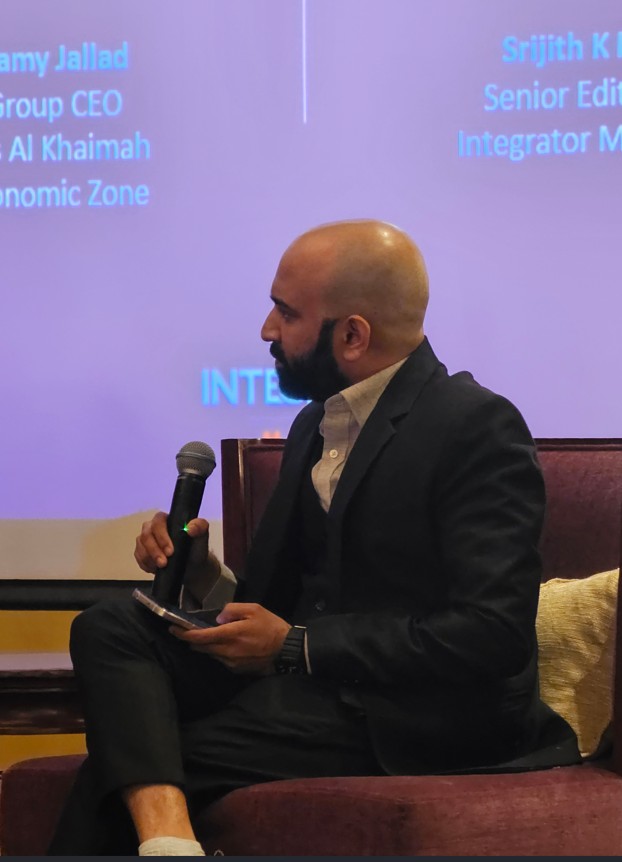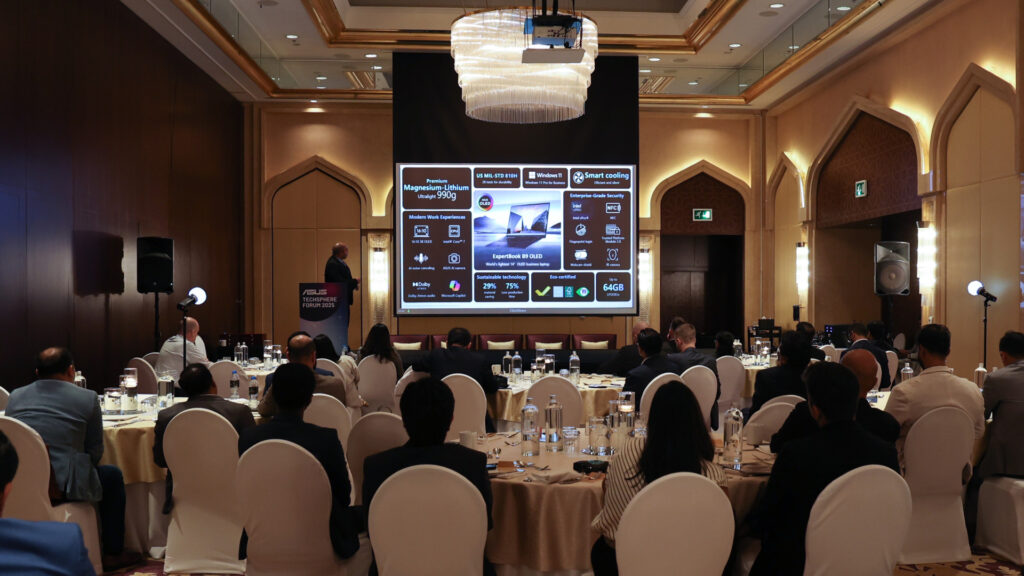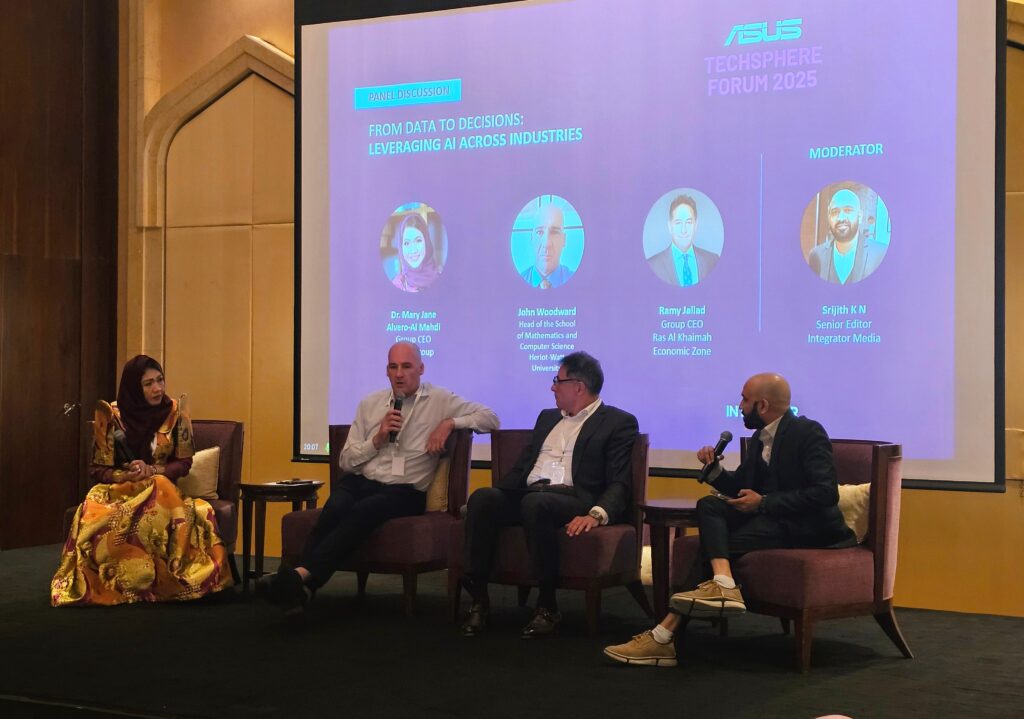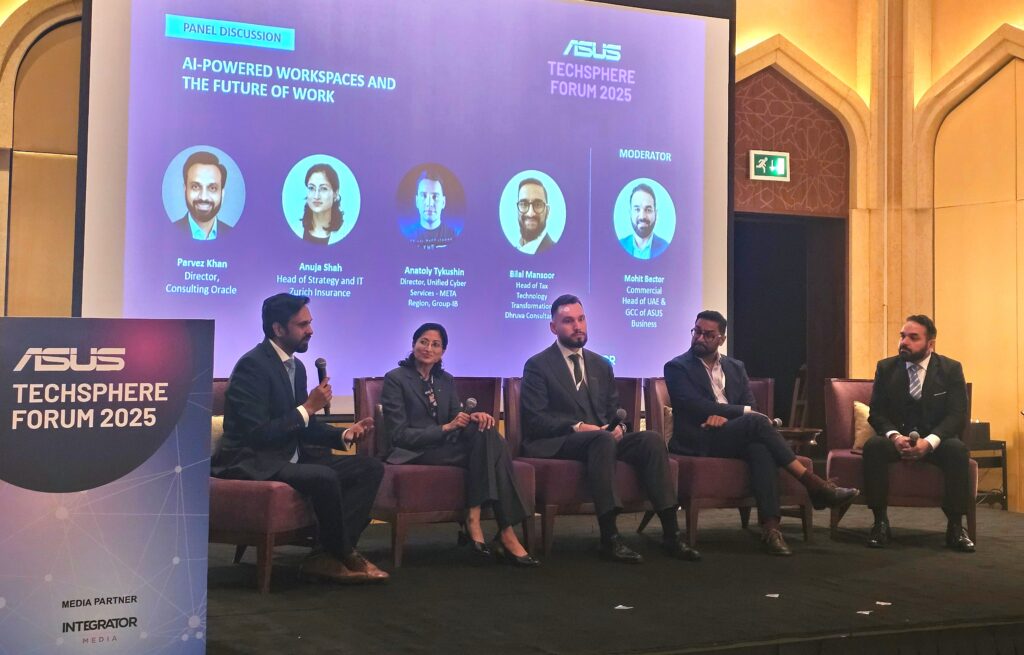Tech Features
ASUS Techsphere Forum: Empowering Business Leaders Through Next-Gen Hardware Innovation

The line on the opening slide— “Every company will be an AI company”—wasn’t tossed out as a provocation. At the ASUS Techsphere Forum 2025 in Dubai, it landed as an operating instruction. The message across keynotes, the Intel segment, and two candid panels was strikingly consistent: AI stops being theatre the moment you standardize three things—the workspace (where people actually work), the runtime (so models are portable), and the portfolio (so you manage dozens of use cases like a product backlog, not a parade of proofs-of-concept).

Subrato Basu, Managing Partner, Executive Board

Srijith KN,
Senior Editor,
Integrator Media
A quick reality check on market size so we’re not drinking our own Kool-Aid: the global AI market in 2025 is roughly $300–$400B, depending on scope (software vs. software + services + hardware). Reasonable consensus ranges put 2030 at ~$0.8–$1.6T. In other words, still early—but already too big to treat as a side project.

ASUS: PUT AI ON THE ENDPOINT—AND MAKE IT GOVERNABLE
ASUS’s enterprise stance is disarmingly practical. As Mohit Bector, Commercial Head (UAE & GCC) at ASUS Business, framed it, the fastest way to make AI useful is to put it where the work happens (the endpoint) and to make it governable. Concretely, that means:
- NPUs for on-device inference (privacy, latency, battery life).
- Manageability (fleet policy, remote control, security posture you can actually audit).
- Longevity (multi-year BIOS/driver support) so IT can set an AI-ready baseline and keep it stable.
ASUS thinks about the modern workplace as an Enter → Analyse → Decide loop, this is where the workday actually speeds up—quietly, relentlessly, at the endpoint:
- Enter: the device captures signals—voice, docs, screens, forms, sensors.
- Analyse: retrieval-augmented reasoning + analytics produce options, risks, and rationales.
- Decide: humans choose; agents act—raise tickets, update ERP/CRM—with audit trails.
It isn’t about one blockbuster use case. It’s about standardizing the canvas, so small wins compound every week.

INTEL: FROM SLOGAN TO STACK (AND WHY THE AI PC MATTERS)
Intel’s deck made the “every company will be an AI company” claim implementable. Four slide-level words—Open, Innovative, Efficient, Secure—double as a buyer checklist:
- Open: less cost, no lock-in. The same models should move across CPU/GPU/NPU and PC → Edge → Datacentre/Cloud without rewrites.
- Innovation: treat AI PCs with NPUs, edge systems, and cloud clusters as one continuum.
- Efficient: lead on performance per dollar and per watt; energy and cost are first-class design goals.
- Secure: your data and your models are IP; run locally when you should, govern tightly when you don’t.
A “Power of Intel Inside” platform slide stitched this together:
- AI software & services: OpenVINO as the portability layer to convert/optimize/run models across heterogeneous silicon.
- AI PC: always-on, private inference for day-to-day assistants.
- Edge AI: near-machine intelligence for vision and time-series use cases.
- Datacentre & cloud AI: scale-out training/heavy inference (fraud graphs, multimodal analytics, enterprise RAG).
- AI networking: the fabric that keeps it all moving—securely.
Why the fuss about the AI PC? Because it’s the next enterprise inflection after Windows and Wi-Fi. Slides mapped tangible outcomes:
- Productivity: faster info-find, auto-drafts, note-taking.
- Communication: translation, live captioning, dictation, transcription.
- Collaboration: smart framing, background removal, eye tracking, noise suppression—without pegging the CPU.
- IT operations: endpoint anomaly detection, VDI super-resolution, remote screen/data removal.
- Security: client-side deepfake detection, anti-phishing, ransomware flags.
Under the hood, Intel’s definition is a division of labour: CPU for responsiveness and orchestration, GPU for high-throughput math/creation, NPU for low-power sustained inference—the always-on stuff that makes assistants truly useful. Add vPro + Core Ultra and you get the fleet controls and long-term stability IT actually needs.
One more practical bit I liked: Intel AI Assistant Builder—a portal to stand up local assistants/agents (with RAG) that can run on the PC fleet first, shrinking time-to-value from months to days/weeks and letting you prove the full E-A-D loop before you scale heavier jobs to edge/cloud.
When the “100M AI PCs by 2026” slide hit the screen, heads tilted from curiosity to calculation. The figures—bullish vendor projections (~100M by 2026; ~80% AI-capable by 2028)—invite a haircut, but the signal is unmistakable: endpoint AI is becoming the default.

WHAT THE PANELLISTS REALLY TAUGHT US
RAKEZ (Free Trade Zone)
Posture: Execution-first. Make AI practical on the shop floor and trustworthy in the back office—governed from day one.
What they drive:
- Diagnostics (OEE baselines, defect maps) + data-readiness scans (MES/ERP) so pilots don’t stall.
- Reference lines/sandboxes where vendors prove accuracy, safety, throughput before purchase.
- Template playbooks: CV-QC, predictive maintenance, warehouse vision, invoice extraction/3-way match—each with SOPs, KPIs, integration steps.
- Curated vendors + shared services (labelling, model hosting/monitoring, SOC for AI) to reduce MSME cost/complexity.
MSMEs: “Bookkeeping-in-a-box” to clean ledgers and free cash; pre-negotiated PoC packs (fixed price/timeline, acceptance metrics); compliance starter kit (consent, retention, safety, escalation).
Enterprises: Multi-site rollout playbooks, edge + cloud reference architectures (identity-aware RAG, policy-constrained agents), and assurance artifacts (model cards, change control, audit trails).
Outcome lens: OEE ↑, FPY ↑/DPMO ↓, MTBF ↑/MTTR ↓, faster close cycles, fewer incidents—AI that moves the P&L and passes audit.
Note – FPY — First Pass Yield; OEE — Overall Equipment Effectiveness; DPMO — Defects Per Million Opportunities; MTBF — Mean Time Between Failures (repairable systems); MTTR — Mean Time To Repair
Oracle (Consulting / Applications cloud)
Posture: AI belongs inside the workflows where finance, HR, supply chain, and service teams live. Expect talk tracks like: ground answers in your own records (RAG with policy), instrument before/after outcomes, and treat AI features as part of ERP/HCM/CX—not a sidecar chatbot. The ask from buyers: prove the Enter → Analyse → Decide gains in real workflows (FP&A forecasting lift, supplier risk scoring, HR talent match quality).
Zurich Insurance (BFSI)
Posture: AI as a force for good, scaled with governance. Think hundreds of use cases: claims triage, fraud/anomaly detection, internal knowledge bots—human-in-the-loop where stakes are high, and IoT-style prevention to reward good behaviour. The key is measurement: fewer false positives, shorter cycle times, clearer audit trails—and elevated roles, not replaced ones.
Group-IB (Cyber / Threat Intel)
Posture: AI to defend—and defend against AI. SOC copilots that summarize and enrich alerts, deepfake/phishing detection, behaviour analytics across identities and endpoints, and the emerging discipline of security of AI (prompt-injection defences, LLM gatewaying, data loss controls for AI apps). If you’re rolling out agents, involve your security team early.
Dhruva Consultants (Tax Tech Transformation)
Posture: RegTech + AI to reduce compliance cost and risk. Document AI to normalize invoices/contracts, anomaly detection for mismatches and fraud flags, and a pragmatic “bookkeeping-in-a-box” on-ramp for MSMEs. Non-negotiables: auditability, versioning, segregation of duties for anything that touches filings.
Prime Group (Labs/Certification)
Posture: Risk-scored processes—every lab step tagged with expected outputs, data access, and fallbacks. Near-term wins: smarter scheduling and test selection; long-term horizon: a Mars-ready lab by 2050 aligned with the UAE’s space ambitions. It’s operational excellence today, exploration mindset tomorrow.
Education (Heriot-Watt University, Dubai)
Posture: candid and useful: human-led pedagogy; AI-assisted admin and decision support. HWU brings talent pipelines (AI/Data Science programs), translational research, and applied robotics capacity (think Robotarium-style ecosystems). This is the repeatable talent + research engine enterprises can plug into—capstones, CPD, joint R&D—that shortens the path from idea to pilot.
WHY UAE HAS A STRUCTURAL ADVANTAGE: RAKEZ × HWU
Local context matters. RAKEZ (Ras Al Khaimah Economic Zone) is more than a location; it’s an adoption on-ramp aligned with MoIAT’s Industry 4.0 programs (ITTI/Transform 4.0). Translation: factories—especially MSMEs—get real help to deploy vision-led quality, OEE analytics, and worker-safety use cases, with policy scaffolding and incentives attached.
Pair that with Heriot-Watt University as a talent/research flywheel and you have a short, well-lit path from concept to production: execution zone + skills engine. That’s a genuine regional edge.
SUMMARY
Techsphere’s most important contribution wasn’t a prediction; it was a design pattern. ASUS gives you the enterprise substrate (AI-ready endpoints you can actually govern). Intel gives you the principles and plumbing (OpenVINO portability; CPU/GPU/NPU continuum; PC → Edge → Cloud). The panellists supplied proof patterns across industries. And the UAE context—RAKEZ for execution, HWU for talent/research—shortens the distance from idea to impact.
If “every company will be an AI company,” the winners won’t be the first to demo—they’ll be the first to standardize. Start at the endpoint, insist on portability, manage a portfolio, and make the Enter → Analyse → Decide loop measurable. That’s how the slide turns into the balance sheet.
_________________________________________________________
- Glossary of Technical Acronyms
- OEE — Overall Equipment Effectiveness (measures manufacturing productivity: availability × performance × quality).
- FPY — First Pass Yield (percentage of units passing production without rework).
- DPMO — Defects Per Million Opportunities (defect rate in Six Sigma terms).
- MTBF — Mean Time Between Failures (average time between breakdowns of a repairable system).
- MTTR — Mean Time To Repair (average time to repair a failed component/system).
- AI / IT Terms
- NPU — Neural Processing Unit (specialized chip for AI inference, optimized for low-power sustained workloads).
- CPU — Central Processing Unit (general-purpose processor for orchestration, responsiveness).
- GPU — Graphics Processing Unit (parallel processor for high-throughput math and AI training/inference).
- RAG — Retrieval-Augmented Generation (technique where AI models query external knowledge bases before generating answers).
- ERP — Enterprise Resource Planning (integrated system for core business processes like finance, supply chain, manufacturing).
- MES — Manufacturing Execution System (software for monitoring and controlling production).
- VDI — Virtual Desktop Infrastructure (running desktop environments on centralized servers).
- SOC — Security Operations Center (hub for cybersecurity monitoring and response).
- IP — Intellectual Property (protected data, models, or designs).
- Industry & Enterprise Acronyms
- BFSI — Banking, Financial Services, and Insurance (industry vertical).
- FP&A — Financial Planning & Analysis (finance function for budgeting, forecasting, performance analysis).
- HCM — Human Capital Management (HR technology and processes).
- CX — Customer Experience (customer-facing processes and software).
- ITTI — Industrial Technology Transformation Index (UAE Ministry of Industry and Advanced Technology initiative under Industry 4.0).
The ASUS Techsphere Forum, organized by Integrator Media, brought together C-suite leaders from diverse industry verticals to explore how evolving hardware standards are shaping the future of work. The event highlighted the growing role of AI-enabled PCs, showing how advancements in endpoint hardware can directly support business needs. By balancing industry-specific requirements with insights on hardware innovation, the forum offered executives a clear view of how these technologies can enhance productivity and deliver measurable value across the wider business community.
Tech Features
HOW GCC OPERATORS CAN LEAD THE NEXT AI WAVE WITH FUTURE-PROOF OPTICAL NETWORKS

By Pete Hall, Regional Managing Director, Ciena Middle East & Africa
Artificial Intelligence (AI) is advancing at a rapid pace in the region, driving innovation across various industries. The GCC now stands at a pivotal moment, with AI transitioning from a hyperscaler-centric phenomenon to a ubiquitous force shaping enterprise and consumer networks alike.
Globally, Amazon Web Services (AWS), Google Cloud, Microsoft Azure and NVIDIA have stepped in to manage large-scale computing and data processing needs. Unlike traditional data centers, they are built to meet evolving workloads without major infrastructure changes.
The rapid expansion of data centres to meet soaring demand is also evident in the UAE, where du announced a deal with Microsoft to set up a data centre in the country to revolutionize the digital ecosystem. Next door, Saudi Arabia has been expanding its investments in data centres to drive its wider ambitions to become a regional AI leader and global tech hub.
While much of the AI optics boom has so far been confined to data center interconnects, growth is now shifting from AI model training to AI inferencing, where AI models can make accurate predictions based on new data. However, it takes data-intensive AI training to make this a reality.
As new AI applications such as AI-powered analytics, immersive media, and automation are expected to surge through 2030, the next wave will demand robust, low-latency, high-capacity optical transport across metro and long-haul networks.
In particular, GCC markets are primed to experience rapid uptake due to national AI agendas and smart city initiatives. A 2025 survey shows AI traffic could account for 30–50% of metro and long-haul capacity within three years. It is interesting to note that enterprises, not hyperscalers, are expected to drive the most network traffic growth over this period.
As the AI traffic boom moves beyond the data centre, low latency, high capacity, and resilient optical links will be the key differentiators for AI-driven workloads. This is precisely where regional telcos can take the lead. The market for capacity is already evolving quite rapidly.
Earlier this year, e& UAE became the first in the Middle East and Africa to deploy Ciena’s WaveLogic 6 Extreme, achieving ultra-high-speed 1.6 Tb/s per wavelength connectivity. This advancement supports 10 Gb home services and wholesale and domestic business customer traffic with 100G and 400G requirement.
The GCC’s investment in high-capacity optical networks, powered by new innovations such as WaveLogic 6, provides a competitive advantage in meeting the increasing AI traffic demands. If they are to take this to the next level, GCC telcos must capitalize on their relatively greenfield networks to deploy future-proof optical infrastructures faster than more mature markets constrained by legacy systems.
GCC operators are charting a new course as AI enablers, leveraging managed optical fiber networks and AI-optimized SLAs to deliver greater value and innovation beyond traditional bandwidth services.
To accelerate this journey and speed time to market, operators are also taking steps to address capex constraints, skill gaps, and organizational alignment. By positioning themselves as AI ecosystem leaders, they can unlock long-term revenue and resilience.
There is a real window of opportunity for GCC operators to capitalise on the AI optical wave. Thanks to national AI strategies, sovereign cloud initiatives, and hyperscaler partnerships, they already have a head start. By continuing to invest in future-proof, high-capacity, low-latency optical networks they can ensure network readiness for AI’s exponential traffic growth. The next three years will determine whether GCC operators shape the AI economy or chase it.
Tech Features
5 KEY TECHNOLOGY TRENDS AFFECTING THE SECURITY SECTOR IN 2026

By Johan Paulsson, Chief Technology Officer at Axis Communications; Matt Thulin, Director of AI & Analytics Solutions at Axis Communications; and Thomas Ekdahl, Engineering Manager – Technologies at Axis Communications
It came as a surprise that this is the 10th time that we’ve looked at the technology trends that we think will affect the security sector in the coming year. It feels like only yesterday that we sat down to write the first – a reminder of how quickly time passes, and how fast technological progress continues to move.
Something that’s also become clear is that a completely new set of trends doesn’t appear year-on-year. Rather, we see an evolution of trends and technological developments, and that’s very much the case as we look towards 2026. Technological innovations regularly arrive, which impact our sector. Artificial intelligence, advancements in imaging, greater processing capabilities within devices, enhanced communications technologies…these and more have impacted our industry.
Even technologies which still seem a distance away, such as quantum computing, may have some potential implications in the near-term in preparing for the future. While we focus here on tech trends, it’s worth highlighting a shift that we’ve seen in recent years: the increasing involvement and influence of the IT department over decisions related to security and safety technology. The physical security and IT departments now work in close collaboration, with IT heavily involved in physical security purchasing decisions.
That influence, we feel, is central to the first of our trends for 2026…
1. “Ecosystem-first” becomes an important part of decision making
At a fundamental level, the greater influence of the IT department is changing the perspective regarding security technology purchasing decisions. We call this an “ecosystem-first” approach, and it influences almost every subsequent decision. Today, however, we start to see a trend that the first decision is increasingly defined by the solution ecosystem to which the customer wants to commit. In many ways, it’s analogous to how IT has always worked: decide on an operating system, and then select compatible hardware and software.
The ecosystem-first approach makes a lot of sense. With today’s solutions including a greater variety of devices, sensors, and analytics than ever before, seamless integration, configuration, management, and scalability is essential. In addition, product lifecycle management, including, critically, ongoing software support, becomes more achievable within a single ecosystem.
Committing to a single ecosystem – one offering breadth and depth in hardware and software from both the principal vendor alongside a vibrant ecosystem of partners – is the primary decision.
2. The ongoing evolution of hybrid architectures
A hybrid architecture as the preferred choice isn’t new. In fact, it’s something we’ve highlighted in previous technology trends posts. But it continues to evolve. Sometimes evolution can seem quite subtle. In reality, we’re seeing some fundamental shifts.
We’ve always described hybrid as a mix of edge computing within cameras, cloud resources, and on-premise servers. While that’s still the same today, what’s changing is the balance of resources, as capabilities are enhanced and new use cases emerge. Edge and cloud are becoming much more significant, with the need for on-premise server computing resources reduced.
This is largely a result of enhanced computing power and capabilities within both cameras and the cloud. More powerful edge AI-enabled surveillance cameras can, put simply, handle more than ever before. Improved image quality, the ability to more accurately analyze scenes and create valuable metadata have seen cameras take on tasks previously handled on the server.
Similarly, with such a wealth of data being created, cloud-based resources have the analytical power required to surface business intelligence and insights to enhance operational effectiveness.
There can still be legitimate reasons to retain some on-premise resources, such as network video recorders, but the true value is increasingly coming from edge devices and cloud resources. Ultimately, it’s a trend that meets both the IT department’s drive for efficiency, the security team’s desire for solution quality and effectiveness, and the data integrity and security needs of both.
But, even if hybrid architectures are a trend, we must not forget that a vast majority of all solutions are still very much on-prem solutions, and this will be the case for a long time.
3. The increased importance of edge computing
In many sectors, like the automotive industry, the need and potential for edge computing has only been recognized relatively recently. As regular readers will know, however, the value of increased computing resources within devices at the edge of the network has been a feature of our technology trends predictions for several years. Enhanced capabilities mark the beginning of a new era of edge.
In many ways, the increased importance of edge computing is directly related to the evolution of hybrid architectures described in the previous trend. When hybrid solutions have included edge, cloud, and server technologies, the full potential of edge AI hasn’t always been fully realized. With on-premise servers able to support some tasks, there has been less motivation to move these to the edge.
This is already changing and will accelerate over the coming year. This is in part due to the enhanced AI available to the edge, within devices themselves. The discussion and decisions about where to deploy AI across surveillance solutions – using the strengths of edge AI in devices and the power of cloud-based analytics – has brought focus to the capabilities of cameras and the increasing variety of edge AI-enabled sensors. These bring benefits in both effectiveness and efficiency.
Edge processing generates both business data — actionable insights derived directly from the scene — and metadata, which describes the objects and scenes within it. This information has become the basis for efficient scaling of system functionality, such as smart video searches, and for generating system wide insights. Edge processing enables a much smoother scaling of system compute performance, as the system performance grows with each added edge device.
The arguments against moving more to the edge, such as cybersecurity challenges, have diminished. With the strong cybersecurity capabilities of edge devices, such as secure boot and signed OS, they now have become a strong part of the overall system security solution.
4. Mobile surveillance on the rise
Mobile surveillance solutions, like mobile trailers, aren’t a trend in themselves. For numerous reasons – commercial and technological – mobile surveillance has already seen significant growth and is set to explode over the next year.
From a technological perspective, improved connectivity has helped unlock the ability to employ more advanced, higher-quality surveillance cameras in mobile solutions. Remote access and edge AI has further enhanced the capabilities of mobile surveillance solutions. This immediately makes them an attractive option in a greater variety of situations, from public safety to construction sites to festivals and sporting events.
Power management within surveillance cameras has also advanced, resulting in lower power utilization without a compromise in quality. This is particularly important where mobile surveillance solutions are making use of battery power and renewable energy. A mobile surveillance solution can also be more straightforward to approve than a permanent installation.
Ultimately, these factors mean that security and safety can be ensured in places where it is difficult or undesirable to place physical security personnel.
5. Technology autonomy: Easier said than done!
Less a new trend, and more a reflection on one of our trends from last year where we highlighted how companies across many sectors were looking to gain more control over key technologies essential to their products. Automotive companies looking to design their own semiconductors to mitigate against supply chain disruption was an example.
As many of those organizations are finding, however, extending an organization’s focus from its traditional business (e.g. making cars) to a fundamentally different and potentially highly complex area (e.g. designing semiconductors) is easier said than done. Attempts also highlight how interconnected global supply chains are, and that true autonomy is impossible to achieve.
As we have done for many years here at Axis, focus for technological autonomy should be on the areas of a business that make a fundamental difference to the offering. Designing our own system-on-chip (SoC), ARTPEC, which Axis started doing more than 25 years ago, has given us ultimate control over our product functionality.
An example of the benefit of this has been our ability to be the first surveillance equipment vendor to provide AV1 video encoding to our customers and partners, in addition to H.264 and H.265. It also allows us to prepare for future technologies that will bring opportunities and risks, even those that still seem many years in the future.
While we always enjoy putting together our thoughts on the trends that will define the industry over the coming year, our perspective stretches much further into the future. This is what gives us the ability to plan for and develop the innovations that continue to meet the evolving needs of customers, and opportunities to improve safety, security, operational efficiency and business intelligence.
Innovation doesn’t happen in isolation, however. The best ideas emerge through collaboration, by listening to our customers and understanding their challenges, by maintaining close relationships with our partners, and by exploring solutions together. These partnerships are what will continue to drive progress as we move into 2026 and beyond, whichever way the technological winds may blow.
Tech Features
GenAI App Ad Spend Hits US$824M as AppsFlyer Reveals First AI Agent Usage Data

AppsFlyer has released its annual analysis of mobile app trends, revealing how AI shaped both consumer behavior and marketing strategy in 2025. GenAI adoption accelerated across the app ecosystem, with installs up 16% and category spend reaching US$824M across iOS and Android. GenAI apps ranked among the fastest-growing categories of the year, no.1 in Android and no.4 in iOS, reflecting their expanding role in creative, productivity, and AI assistant experiences.
AppsFlyer also analyzed AI agent usage for the first time, identifying how marketers are integrating AI into their performance workflows. The data shows that 57% of agent deployments focused on technical automation such as configuration and data-integrity checks, while 32% supported business optimization. Distinct usage patterns emerged across verticals: gaming marketers used agents to improve efficiency and protect margins, while retail and fintech teams relied on them to scale traffic and volume. These trends point to an early but meaningful shift toward supervised automation, where AI supports decision-making while marketers maintain strategic oversight.
“Many marketers say they are still struggling to measure clear ROI from AI, yet the adoption curve tells a different story,” said Inna Weiner, VP Product, Data and AI, AppsFlyer. “GenAI apps are accelerating in consumer adoption, and behind the scenes marketers are increasingly deploying agents to simplify workflows and improve efficiency. AppsFlyer remains committed to helping teams navigate this rapidly evolving landscape with the clarity and confidence they need to grow.”
Beyond the rise of AI in both apps and marketing workflows, the report outlines several broader trends shaping the app economy in 2025.
Additional Marketing Trends of 2025
- Global UA spend rises 13% to US$78B, driven entirely by iOS and mostly by investment from non-gaming apps: iOS user acquisition spend grew 35% while Android remained flat. Non-gaming increased 18% to US$53B, and gaming grew only 3% to US$25B.
- Remarketing expands as retention gains importance: Remarketing spend grew a significant 37% to US$31.3B, now representing 29% of all app marketing investment (up from 25% in 2024). iOS remarketing rose 71%, with notable gains in Transportation (+362%), Travel (+145%), and Finance (+135%).
- Shopping reshapes global UA spend distribution: Shopping investment to acquire new users rose 70% overall and 123% on iOS, driven by China-based ecommerce budgets that materially shifted category and regional share.
-

 Tech News1 year ago
Tech News1 year agoDenodo Bolsters Executive Team by Hiring Christophe Culine as its Chief Revenue Officer
-

 VAR8 months ago
VAR8 months agoMicrosoft Launches New Surface Copilot+ PCs for Business
-

 Tech Interviews2 years ago
Tech Interviews2 years agoNavigating the Cybersecurity Landscape in Hybrid Work Environments
-

 Tech News5 months ago
Tech News5 months agoNothing Launches flagship Nothing Phone (3) and Headphone (1) in theme with the Iconic Museum of the Future in Dubai
-

 Tech News2 years ago
Tech News2 years agoBrighton College Abu Dhabi and Brighton College Al Ain Donate 954 IT Devices in Support of ‘Donate Your Own Device’ Campaign
-

 VAR1 year ago
VAR1 year agoSamsung Galaxy Z Fold6 vs Google Pixel 9 Pro Fold: Clash Of The Folding Phenoms
-

 Editorial1 year ago
Editorial1 year agoCelebrating UAE National Day: A Legacy of Leadership and Technological Innovation
-

 Cover Story10 months ago
Cover Story10 months agoUnifonic Leading the Future of AI-Driven Customer Engagement























